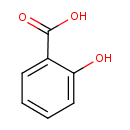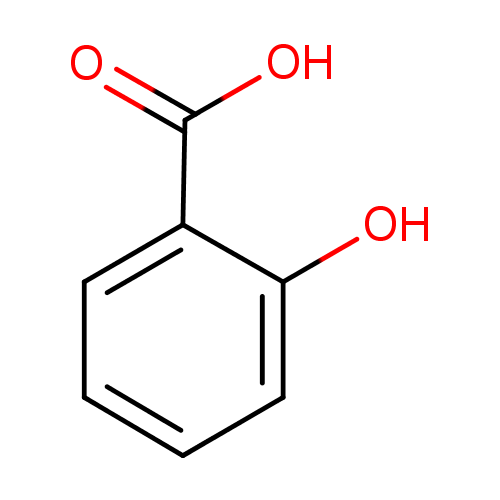|
Record Information |
|---|
| Version |
1.0 |
|---|
| Update Date |
1/22/2018 11:54:54 AM |
|---|
|
Metabolite ID | PAMDB110449 |
|---|
|
Identification |
|---|
| Name: |
salicylate |
|---|
| Description: | A monohydroxybenzoate that is the conjugate base of salicylic acid. |
|---|
|
Structure |
|
|---|
| Synonyms: | -
salicylic acid
-
o-hydroxybenzoic acid
-
2-hydroxybenzoic acid
-
SA
-
2-HBA
-
2-hydroxybenzoate
-
o-hydroxybenzoate
|
|---|
|
Chemical Formula: |
C7H5O3
|
|---|
| Average Molecular Weight: |
138.0316940589 |
|---|
| Monoisotopic Molecular
Weight: |
138.0316940589 |
|---|
| InChI Key: |
YGSDEFSMJLZEOE-UHFFFAOYSA-M |
|---|
| InChI: |
InChI=1S/C7H6O3/c8-6-4-2-1-3-5(6)7(9)10/h1-4,8H,(H,9,10)/p-1 |
|---|
| CAS
number: |
69-72-7 |
|---|
| IUPAC Name: | 2-hydroxybenzoate |
|---|
|
Traditional IUPAC Name: |
salicylic |
|---|
| SMILES: | C(C1(=CC=CC=C1O))([O-])=O |
|---|
|
Chemical Taxonomy |
|---|
|
Taxonomy Description | This compound belongs to the class of organic compounds known as salicylic acids. These are ortho-hydroxylated benzoic acids. |
|---|
|
Kingdom |
Organic compounds |
|---|
| Super Class | Benzenoids |
|---|
|
Class |
Benzene and substituted derivatives |
|---|
| Sub Class | Benzoic acids and derivatives |
|---|
|
Direct Parent |
Salicylic acids |
|---|
| Alternative Parents |
|
|---|
| Substituents |
- Salicylic acid
- Benzoic acid
- Benzoyl
- 1-hydroxy-4-unsubstituted benzenoid
- 1-hydroxy-2-unsubstituted benzenoid
- Phenol
- Vinylogous acid
- Monocarboxylic acid or derivatives
- Carboxylic acid
- Carboxylic acid derivative
- Organic oxygen compound
- Organic oxide
- Hydrocarbon derivative
- Organooxygen compound
- Aromatic homomonocyclic compound
|
|---|
| Molecular Framework |
Aromatic homomonocyclic compounds |
|---|
| External Descriptors |
|
|---|
|
Physical Properties |
|---|
| State: |
Solid |
|---|
| Charge: | -1 |
|---|
|
Melting point: |
158 °C |
|---|
| Experimental Properties: |
| Property | Value | Reference |
|---|
| Melting Point | 158 °C | Not Available | | Boiling Point | Not Available | Not Available | | Water Solubility | 2.24 mg/mL at 25 °C | Not Available | | LogP | 2.26 | HANSCH,C ET AL. (1995) |
|
|---|
| Predicted Properties |
|
|---|
|
Biological Properties |
|---|
| Cellular Locations: |
Not Available |
|---|
| Reactions: | |
|---|
|
Pathways: |
Not Available |
|---|
|
Spectra |
|---|
| Spectra: |
| Spectrum Type | Description | Splash Key | |
|---|
| GC-MS | GC-MS Spectrum - GC-MS (2 TMS) | splash10-014i-3890000000-62eae168a9d7ab3ada6f | View in MoNA |
|---|
| Predicted GC-MS | Predicted GC-MS Spectrum - GC-MS | Not Available |
|---|
| LC-MS/MS | LC-MS/MS Spectrum - Quattro_QQQ 10V, Negative (Annotated) | splash10-059j-9600000000-54545731fceee84be340 | View in MoNA |
|---|
| LC-MS/MS | LC-MS/MS Spectrum - Quattro_QQQ 25V, Negative (Annotated) | splash10-00xu-9500000000-2f1c989b672669aaf083 | View in MoNA |
|---|
| LC-MS/MS | LC-MS/MS Spectrum - Quattro_QQQ 40V, Negative (Annotated) | splash10-0gb9-9000000000-a0049e982e8ecd7ab730 | View in MoNA |
|---|
| LC-MS/MS | LC-MS/MS Spectrum - LC-ESI-QQ (API3000, Applied Biosystems) 10V, Negative | splash10-000i-0900000000-f1e71df6894bcc8dda74 | View in MoNA |
|---|
| LC-MS/MS | LC-MS/MS Spectrum - LC-ESI-QQ (API3000, Applied Biosystems) 20V, Negative | splash10-0006-9200000000-f9fd317c182ec7ca90dc | View in MoNA |
|---|
| LC-MS/MS | LC-MS/MS Spectrum - LC-ESI-QQ (API3000, Applied Biosystems) 30V, Negative | splash10-0006-9000000000-2b17aea4ee0ddd6321cf | View in MoNA |
|---|
| LC-MS/MS | LC-MS/MS Spectrum - LC-ESI-QQ (API3000, Applied Biosystems) 40V, Negative | splash10-0006-9000000000-320b7cd879b61439cf42 | View in MoNA |
|---|
| LC-MS/MS | LC-MS/MS Spectrum - LC-ESI-QQ (API3000, Applied Biosystems) 50V, Negative | splash10-0006-9000000000-7d1b96d60026076a7ecc | View in MoNA |
|---|
| Predicted LC-MS/MS | Predicted LC-MS/MS Spectrum - 10V, Positive | Not Available |
|---|
| Predicted LC-MS/MS | Predicted LC-MS/MS Spectrum - 20V, Positive | Not Available |
|---|
| Predicted LC-MS/MS | Predicted LC-MS/MS Spectrum - 40V, Positive | Not Available |
|---|
| Predicted LC-MS/MS | Predicted LC-MS/MS Spectrum - 10V, Negative | Not Available |
|---|
| Predicted LC-MS/MS | Predicted LC-MS/MS Spectrum - 20V, Negative | Not Available |
|---|
| Predicted LC-MS/MS | Predicted LC-MS/MS Spectrum - 40V, Negative | Not Available |
|---|
| MS | Mass Spectrum (Electron Ionization) | splash10-00du-9600000000-6d4a0ff2d48d814b5c54 | View in MoNA |
|---|
| 1D NMR | 1H NMR Spectrum | Not Available |
|---|
| 1D NMR | 1H NMR Spectrum | Not Available |
|---|
| 1D NMR | 13C NMR Spectrum | Not Available |
|---|
| 2D NMR | [1H,1H] 2D NMR Spectrum | Not Available |
|---|
| 2D NMR | [1H,13C] 2D NMR Spectrum | Not Available |
|---|
|
|---|
|
References |
|---|
| References: |
- Raskin I (1992)Salicylate, a new plant hormone. Plant physiology 99, Pubmed: 16669002
- Ruiz-Sanchez E, O'Donnell MJ (2006)Characterization of salicylate uptake across the basolateral membrane of the malpighian tubules of Drosophila melanogaster. Journal of insect physiology 52, Pubmed: 16934829
|
|---|
| Synthesis Reference: |
Yin, Yingwu; Guo, Qingbin. Preparation of salicylic acid from phenol. Faming Zhuanli Shenqing Gongkai Shuomingshu (2005), 7pp. |
|---|
| Material Safety Data Sheet (MSDS) |
Download (PDF) |
|---|
|
Links |
|---|
| External Links: |
|
|---|


